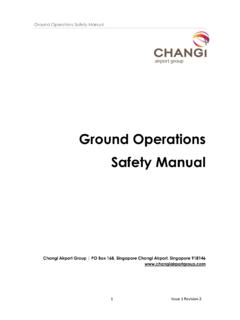Transcription of Introduction to Airports Design and Operations
1 George Mason University Center for Air Transportation Systems Research Unit: Introduction to Airports Design and Operations SYST460/560 Fall 2009 Instructor: Dr. Lance Sherry, 1 Introduction to Airports Design and Operations Learning Objectives: Student will be able to describe the following terms: Terminal building Concourses Runways Hangars Landside Airside Fixed-base Operators Air Traffic Control Emergency Services Airbase Airfield Airstrip Aerodrome Ramp Apron Jetbridge Air Traffic Control Customs Cargo & Freight Services Navigation Aids ICAO iata ground Control Tower Control Controlled Airspace Movement Areas Traffic Pattern Navigational Aid ATIS VASI VOR DME PAR ILS Location Signage Direction/Runway Signage Change Frequency Signage Holding Position Signage Runway Lighting Runway Edge Lighting Taxiway Lighting Taxiway Edge Lighting Wind Sock Windshear airport /Facility Directory airport Diagram George Mason University Center for Air Transportation Systems Research Unit: Introduction to Airports Design and Operations SYST460/560 Fall 2009 Instructor: Dr.
2 Lance Sherry, 2 Table of Contents Introduction to Airports Design and Operations .. 1 Airports .. 3 airport Characteristics .. 3 airport Structures .. 3 International Customs .. 4 Shops and Food Services .. 4 Cargo and Freight Services .. 5 Support Services .. 5 History and Development .. 5 airport Designation and Naming .. 6 Security .. 6 airport 7 Air Traffic Control .. 7 Traffic Pattern vs. Scheduled Operations .. 7 airport - Navigational Aids .. 8 Guidance Signs .. 9 Lighting .. 9 Wind Indicators .. 10 Safety Management .. 10 Environmental Concerns .. 12 airport Directories .. 12 George Mason University Center for Air Transportation Systems Research Unit: Introduction to Airports Design and Operations SYST460/560 Fall 2009 Instructor: Dr. Lance Sherry, 3 Airports An airport is a facility where passengers connect from/to ground transportation to air transportation.
3 Descriptions of Airports can be divided into landside and airside. Landside descriptions cover how passengers arrive/depart the airport terminal building and move through the terminal building to board the airplanes. Airside describes the movement of the airplanes on the Airports surface. At the very minimum, an airport consists of one runway (or helipad), but other common components are hangars and terminal buildings. Apart from these, an airport may have a variety of facilities and infrastructure, including fixed base operator services, air traffic control, passenger facilities such as restaurants and lounges, and emergency services. A military airport is known as an airbase in North American terminology. The terms airfield and airstrip may also be used to refer to a facility that has nothing more than a runway.
4 The term aerodrome refers to any surface used for take off or landing. The term airport refers to an aerodrome that is licensed by the responsible government organization (ie FAA). Airports have to be maintained to higher safety standards. There is usually no minimum standards for a basic aerodrome. airport Characteristics Airports vary in size, with smaller or less-developed Airports often having only a single runway shorter than 1,000 m (3,300 ft). Larger Airports for international flights generally have paved runways 2,000 m (6,600 ft) or longer. Many small Airports have dirt, grass, or gravel runways, rather than asphalt or concrete. In the United States, the minimum dimensions for dry, hard landing fields are defined by the FAR Landing And Takeoff Field Lengths. These include considerations for safety margins during landing and takeoff.
5 Typically heavier aircraft require longer runways. The longest public-use runway in the world is at Ulyanovsk-Vostochny International airport , in Ulyanovsk, Russia. It has a length of 16,404ft. As of 2008, there were approximately 50,000 Airports around the world, including 19,815 in the United States alone. airport Structures Airports are divided into landside and airside areas. Landside areas include parking lots, fuel tank farms and access roads. Airside areas include all areas accessible to aircraft, including runways, taxiways and ramps. Access from landside areas to airside areas is George Mason University Center for Air Transportation Systems Research Unit: Introduction to Airports Design and Operations SYST460/560 Fall 2009 Instructor: Dr. Lance Sherry, 4tightly controlled at most Airports .
6 Passengers on commercial flights access airside areas through terminals, where they can purchase tickets, clear security, check or claim luggage and board aircraft. The waiting areas which provide passenger access to aircraft are typically called concourses, although this term is often used interchangeably with terminal. The area where aircraft park next to a terminal to load passengers and baggage is known as a ramp. Parking areas for aircraft away from terminals are generally called aprons. Both large and small Airports can be towered or uncontrolled, depending on air traffic density and available funds. Due to their high capacity and busy airspace, most international Airports have air traffic control located on site. International Customs Customs facilities for international flights define an international airport , and often require a more conspicuous level of physical security.
7 International Airports generally have a complex of buildings where passengers can embark on airliners, and where cargo can be stored and loaded. The largest international Airports are often located next to highways or are served by their own highways. Often, traffic is fed into two access roads, designed as loops, one sitting on top of the other. One level is for departing passengers and the other is for arrivals. Many Airports also have light rail lines or other mass transit systems directly connected to the main terminals. Shops and Food Services Most international Airports have shops and food courts. These services provide passengers food and drinks before they board their flight. Many recognizable chain food restaurants have opened branches in large Airports to serve passengers.
8 London's Heathrow airport , for example, is home to both a Harrods and a Hamleys Toy Shop, providing Duty Free for international passengers. International areas usually have a duty-free shop where travelers are not required to pay the usual duty fees on items. Larger airlines often operate member-only lounges for premium passengers. Airports have a captive audience, and consequently the prices charged for food is generally higher than are available elsewhere in the region. However, some Airports now regulate food costs to keep them comparable to so-called "street prices". George Mason University Center for Air Transportation Systems Research Unit: Introduction to Airports Design and Operations SYST460/560 Fall 2009 Instructor: Dr. Lance Sherry, 5 Cargo and Freight Services In addition to people, Airports are responsible for moving large volumes of cargo around the clock.
9 Cargo airlines often have their own on-site and adjacent infrastructure to rapidly transfer parcels between ground and air modes of transportation. Support Services Aircraft maintenance, pilot services, aircraft rental, and hangar rental are most often performed by a fixed base operator (FBO). At major Airports , particularly those used as hubs, airlines may operate their own support facilities. History and Development The earliest airplane landing sites were simply open, grassy fields. The airplane could approach at any angle that provided a favorable wind direction. Early airfields were often built for the purpose of entertainment. These aerodromes consisted of a grassy field, with hangar for storage and servicing of airplanes, and observation stands for the visitors. Increased aircraft traffic during World War I led to the construction of regular landing fields.
10 Airplanes had to approach these from specified directions. This led to the development of navigation aids for directing the approach and landing slope. Following the war, some of these military airfields added commercial facilities for handling passenger traffic. One of the earliest such fields was Le Bourget, near Paris. The first international airport to open was the Croydon airport , in South London. In 1922, the first permanent airport and commercial terminal solely for commercial aviation was built at K nigsberg, Germany. The Airports of this era used a paved "apron", which permitted night flying as well as landing heavier airplanes. The first lighting used on an airport was during the later part of the 1920s; in the 1930s approach lighting came into use. These indicated the proper direction and angle of descent.










